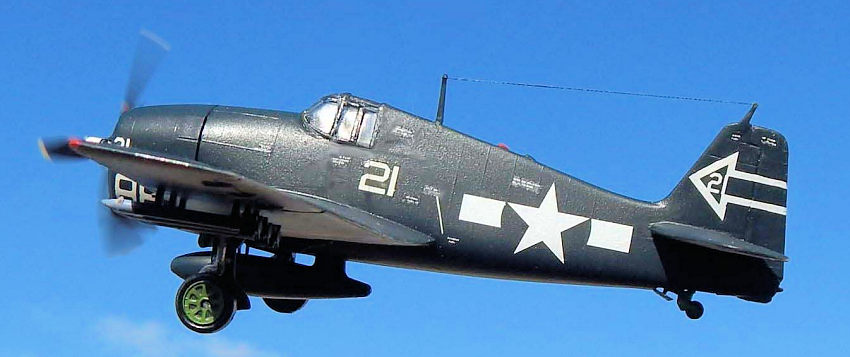
Frog 1/72 F6F-5N Hellcat
| KIT #: | F- |
| PRICE: | $1.00 when new |
| DECALS: | Two options |
| REVIEWER: | Carmel J.Attard |
| NOTES: |
|

| HISTORY |
The Grumman F6F Hellcat is an American carrier-basedfighter aircraftt of World War II. Designed to replace the earlier F4F Wildcat and to counter the Japanese Mitsubishi A6M Zero, it was the United States Navy’s dominant fighter in the second half of the Pacific War. The Hellcat competed with the faster Vought F4U Corsair for that role and prevailed, as the Corsair had significant issues with carrier landings. The Corsair instead was primarily deployed to great effect in land-based use by the U.S. Marine Corps.
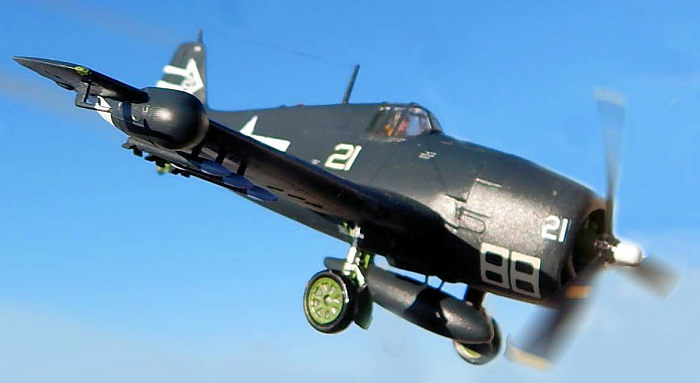 Powered by a 2,000 hp Pratt & Whitney R-2800, the same powerplant used for both
the Corsair and the United States Army Air Force (USAAF) Republic P-47
Thunderbolt fighters, the F6F was an entirely new design, but it still resembled
the Wildcat in many ways. Some military observers tagged the Hellcat as the
"Wildcat's big brother".
Powered by a 2,000 hp Pratt & Whitney R-2800, the same powerplant used for both
the Corsair and the United States Army Air Force (USAAF) Republic P-47
Thunderbolt fighters, the F6F was an entirely new design, but it still resembled
the Wildcat in many ways. Some military observers tagged the Hellcat as the
"Wildcat's big brother".
The F6F was best known for its role as a rugged, well-designed carrier fighter which was able, after its combat debut in September 1943, to outperform the A6M Zero and help secure air superiority over the Pacific Theater. 12,275 were built in just over two years.
In addition to its good flight qualities, the Hellcat was easy to maintain and had an airframe tough enough to withstand the rigors of routine carrier operations. Like the Wildcat, the Hellcat was designed for ease of manufacture and ability to withstand significant damage.
The Hellcat first saw action against the Japanese on 1 September
1943 when fighters off the USS Independence shot down a Kawanishi H8K
"Emily" flying boat. Soon after, on 23 and 24 November, Hellcats engaged
Japanese aircraft over Tarawa, shooting down a claimed 30 Mitsubishi Zeros for
the loss of one F6F.Over Rabaul New Britain, on 11 November 1943, Hellcats and
F4U Corsairs we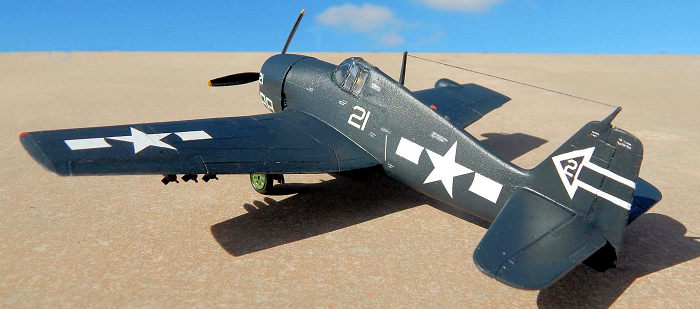 re engaged in day-long fights with many Japanese aircraft
including A6M Zeros, claiming nearly 50 aircraft.
re engaged in day-long fights with many Japanese aircraft
including A6M Zeros, claiming nearly 50 aircraft.
When trials were flown against a captured A6M5 model Zero, they showed that the Hellcat was faster at all altitudes. The F6F out-climbed the Zero marginally above 14,000 ft and rolled faster at speeds above 235 mph. The Japanese fighter could out-turn its American opponent with ease at low speed and enjoyed a slightly better rate of climb below 14,000 ft. The trials report concluded:
Do not dogfight with a Zero 52. Do not try to follow a loop or half-roll with a pull-through. When attacking, use your superior power and high speed performance to engage at the most favourable moment. To evade a Zero 52 on your tail, roll and dive away into a high speed turn.
Hellcats were credited with destroying a total of 5,223 enemy aircraft while in service with the U.S. Navy, U.S. Marine Corps and the Royal Navy Fleet Air Arm. This was more than any other Allied naval aircraft. Postwar, the Hellcat was phased out of front line service but remained in service as late as 1954 as a night fighter.
| CONSTRUCTION |
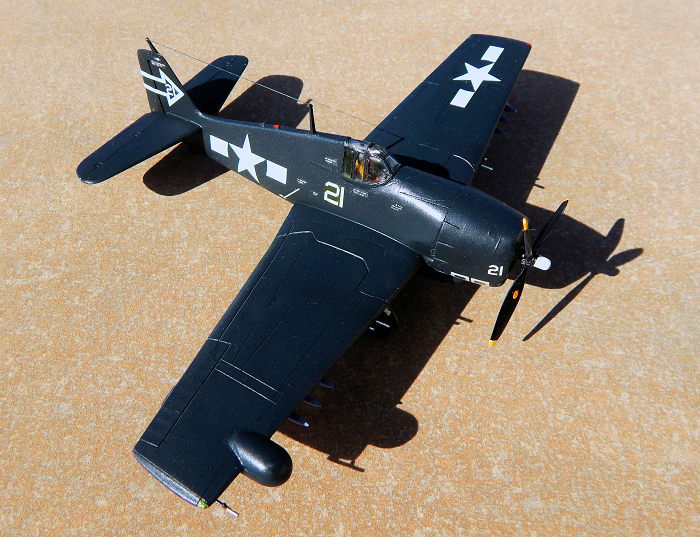 This is an
early Frog kit, acceptable accuracy, injected in light gray styrene with two
decal options of the type in service with the Feet Air Arm during the war years.
This is an
early Frog kit, acceptable accuracy, injected in light gray styrene with two
decal options of the type in service with the Feet Air Arm during the war years.
Building and modifying the Frog Hellcat Mk1 into Hellcat F6F-5N of the US Navy the following was the extra work made on the model:
1 reshaped the tip of tail plane horizontals and increase tail fin chord wise.
2 Widened fin vertical tail tip by 2 mm as they were too narrow
3 blanked the rear windows
4 added short exhaust pipes around cowling as these were missing.
5 added an instrument panel using shaped plastic card and placed instrument decals on it.
6 added wing radar on starboard wing tip (surplus from Eduard kit)
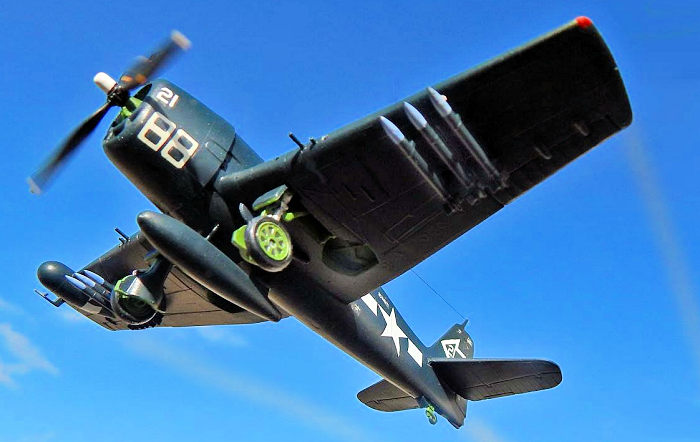 7 added an antenna and wireless,
control column and bulkhead
7 added an antenna and wireless,
control column and bulkhead
8 added structural detail to wheel wells as there was no structural detail inside.
9 replaced wing guns with hollow tubes
10 added fuel tank strap
11 added wing rockets
Kit was sprayed in Compucolor Sea Blue. All interiors were chromate green. Pilot figure painted to USN gear. Wing star and bars are from Blackbird Models BMD 72009, the markings came from Super Scale decal sheet No72-124 which are those of Squadron VF(N)90 US Navy. Model was given a final overall coat of semi gloss lacquer.
| CONCLUSIONS |
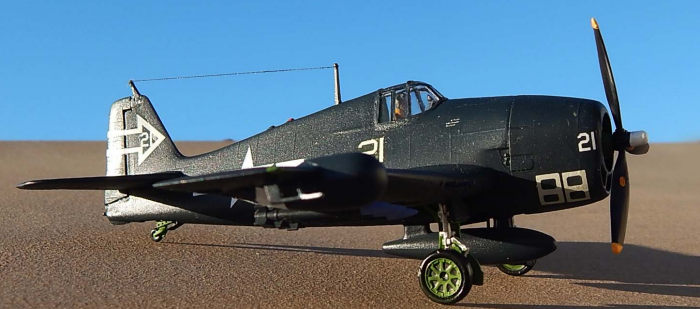 So there it is, a model of three
or more decades ago when it was released. Still it remains a unique model that
offers several interesting markings in USN service and other allied forces.
Parts from more recent mainstream releases made it turn into a pleasing model
using fairly simple construction that was easier than I expected.
So there it is, a model of three
or more decades ago when it was released. Still it remains a unique model that
offers several interesting markings in USN service and other allied forces.
Parts from more recent mainstream releases made it turn into a pleasing model
using fairly simple construction that was easier than I expected.
If you would like your product reviewed fairly and fairly quickly, please contact the editor or see other details in the Note to Contributors.
Back to the Main Page Back to the Review Index Page Back to the Previews Index Page